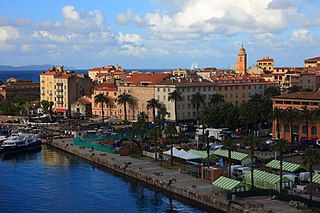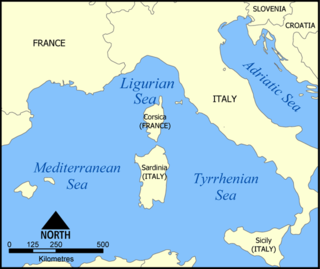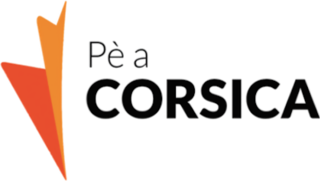
Ajaccio is a French commune, prefecture of the department of Corse-du-Sud, and head office of the Collectivité territoriale de Corse. It is also the largest settlement on the island. Ajaccio is located on the west coast of the island of Corsica, 210 nautical miles (390 km) southeast of Marseille.

Corsican is a Romance language consisting of the continuum of the Italo-Dalmatian dialects spoken on the Mediterranean island of Corsica (France) and on the northern end of the island of Sardinia (Italy). Corsican is related to the varieities of Tuscan from the Italian peninsula, and therefore also to the Florentine-based standard Italian.

Sartène is a commune in the department of Corse-du-Sud on the island of Corsica, France.

Corse-du-Sud is an administrative department of France, consisting of the southern part of the island of Corsica. The corresponding departmental territorial collectivity merged with that of Haute-Corse on 1 January 2018, forming the single territorial collectivity of Corsica, with territorial elections coinciding with the dissolution of the separate council. Although its administrative powers were ceded to the new territorial collectivity, it continues to remain an administrative department in its own right. In 2019, it had a population of 158,507.

Haute-Corse is a department of France, consisting of the northern part of the island of Corsica. The corresponding departmental territorial collectivity merged with that of Corse-du-Sud on 1 January 2018, forming the single territorial collectivity of Corsica, with territorial elections coinciding with the dissolution of the separate councils. However, even though its administrative powers were ceded to the new territorial collectivity, it continues to remain an administrative department in its own right. In 2019, it had a population of 181,933.

L'Île-Rousse is a commune in the Haute-Corse department of France on the island of Corsica.

Bonifacio is a commune in the southern tip of the island of Corsica, in the French department of Corse-du-Sud.

The Corsicans are a Romance Italic ethnic group. They are native to Corsica, a Mediterranean island and a territorial collectivity of France.

Cargèse is a village and commune in the Corse-du-Sud department of France on the west coast of the island of Corsica, 27 km north of Ajaccio. As of 2017, the commune had a population of 1,325.

Corsica is an island in the Mediterranean Sea and one of the 18 regions of France. It is the fourth-largest island in the Mediterranean and lies southeast of the French mainland, west of the Italian Peninsula and immediately north of the Italian island of Sardinia, which is the land mass nearest to it. A single chain of mountains makes up two-thirds of the island. As of January 2023, it had a population of 351,255.

The Archipelago of Lavezzi is a collection of small granite islands and reefs in the Strait of Bonifacio that separates Corsica from Sardinia in the Mediterranean Sea. They are administered from the town of Bonifacio on Corsica.

The history of Corsica goes back to antiquity, and was known to Herodotus, who described Phoenician habitation in the 6th century BCE. Etruscans and Carthaginians expelled the Phoenicians, and remained until the Romans arrived during the Punic Wars in 237 BCE. Vandals occupied it in 430 CE, followed by the Byzantine Empire a century later.

The flag of Corsica was adopted by General of the Nation Pasquale Paoli in 1755 and was based on a traditional flag used previously. It portrays a Moor's head in black wearing a white bandana above his eyes on a white background. Previously, the bandana covered his eyes; Paoli wanted the bandana moved to above the eyes to symbolize the liberation of the Corsican people from the Genoese.

The prehistory of Corsica is analogous to the prehistories of the other islands in the Mediterranean Sea, such as Sicily, Sardinia, Malta and Cyprus, which could only be accessed by boat and featured cultures that were to some degree insular; that is, modified from the traditional Paleolithic, Mesolithic, Neolithic and Chalcolithic of European prehistoric cultures. The islands of the Aegean Sea and Crete early developed Bronze Age civilizations and are accordingly usually treated under those categories. Stone Age Crete however shares some of the features of the prehistoric Mediterranean islands.

The Greek community in France numbers around between 35,000 - 50,000 people. They are located all around the country but the main communities are located in Paris, Marseille and Grenoble.

The Torrean civilization was a Bronze Age megalithic civilization that developed in Southern Corsica, mostly concentrated south of Ajaccio, during the second half of the second millennium BC.

The Defensive Organization of Corsica was the French military organization that in 1940 was responsible for the defense of the French island of Corsica against a potential invasion by Fascist Italy. As part of the overall effort to fortify France's borders which included the Maginot Line, the fixed Corsican defenses were constructed in parallel with the Maginot Line, using the same organizational structure and similar designs, albeit scaled back in size, cost and fighting power. The Corsican defenses were designed to deter an Italian landing on the south end of Corsica, and to support artillery batteries capable of controlling the Strait of Bonifacio between Corsica and the Italian island of Sardinia, separated by only twelve kilometers. As World War II unfolded, no attempt was made by Italian forces to mount an opposed landing on Corsica. The island was instead occupied in November 1942. In 1943 Corsica saw fighting when German forces moved from Sardinia. Most of the fortified positions remain to the present day.

The Italian occupation of Corsica refers to the military occupation by the Kingdom of Italy of the French island of Corsica during the Second World War, from November 1942 to September 1943. After an initial period of increased control over the island, by early spring 1943 the Maquis had begun to occupy the hinterland. In the aftermath of the Armistice of Cassibile, the Italian capitulation to the Allies, some Italian units sided with German troops sent to replace the Italian garrison and some defected to the Maquis and Free French Forces.

Pè a Corsica was a Corsican nationalist political alliance in France, which was calling for more autonomy for Corsica. More specifically, it was a coalition of the two Corsican nationalist parties active on the island; that is, the moderately autonomist Femu a Corsica and the strongly committed separatist Corsica Libera. The party was led by the autonomist Gilles Simeoni. The alliance was renewed for the 2017 territorial election. However, the alliance was dissolved for the 2021 territorial election.
Anti-Corsican sentiment or Anti-Corsianism is hostility, rejection and hatred towards Corsica, Corsican culture or the Corsican ethnic group. In the 21st century, some denounce the use of the term as a victimization phenomenon.


















